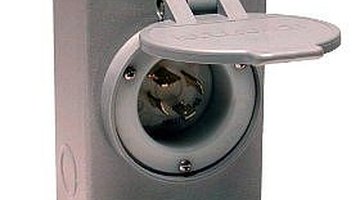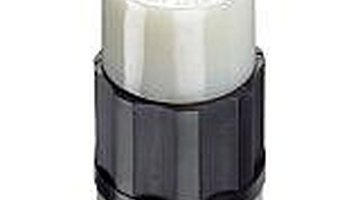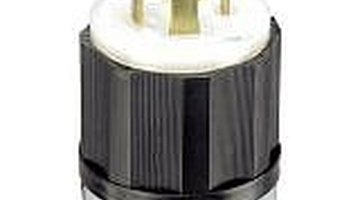How to Connect Generator to house with Transfer Switch
When there is a power outage, you are left in the dark unless you have a back-up generator and transfer switch. This is a device that lets you power chosen household AC circuits either from the power company or from a generator.

When there is a power outage, you just start up your generator, flip a switch, and start powering your appliances with generator power. Here are the basics on how to install a 30 amp transfer switch. Remember there are many brands of transfer switches and each one is a little different. The basic principle is similar in most of them however.
Things You Will Need
- Manual transfer switch.
- Flanged inlet box.
- 240 amp circuit breaker.
- A junction box for every circuit you want to transfer.
- Wire nuts.
- Flexible or rigid 3/4 inch conduit.
- Conduit connectors
- Wire strippers.
- Wire cutters.
- Insulated screwdrivers.
- 3/4 inch drill bit.
- 1/2 inch chuck drill.
Tip
Voltage between red and white terminals is 120 volts AC Voltage between black and white terminals is 120 volts AC Voltage between red and black terminals is 240 volts AC. Voltage between white and green should be zero (0) volts, if not, then you have a grounded hot wire (short circuit) in some appliance or wiring in the house.
Warning
If you have never done any wiring before, call an electrician. Never forget that some of the wires will still be hot even after the main disconnect is off. Use insulated screwdrivers on the circuit breakers.
-
TURN OFF THE MAIN POWER BREAKERS. Be careful because the power company side of the wires are still hot (electrified). Install the transfer switch panel as close as possible (a few inches or so) to the house service panel. Connect the two panels with a length of conduit. You will have to remove a knockout from each panel to do this.
-
Run a length of 10/4 cable between the two panels. Secure the white and ground wires to the appropriate neutral and ground bus bar/s in the service panel, and also in the transfer switch panel.
-
Install a 240 volt 30 amp circuit breaker in the service panel. Connect the red and black wires from the 10/4 cable to this circuit breaker. Insert the circuit breaker into the bus tabs of the service panel. Connect the other end of the red and black wires to the "from power lines" feeder connectors in the transfer switch panel.
-
You will now have to determine what circuits to power with your generator. You will need to add up the wattage of all the appliances that will need powering. Leave about 20% of your generator power in reserve. Motors need this extra power when starting up. A typical refrigerator will use about 700 watts, furnace about 1300 watts. Leave about 250 watts for lights. Added all up, the wattage should be 80% of your generator's power, to leave a reserve.
-
Now comes the messy part. Remove the black wires from the circuit breakers in the service panel. The wires to the circuit you want switched. Depending on your local building codes, you lengthen them in one of two ways. 1. Use wire nuts to extend the above circuit wires so they reach the transfer switch panel through the conduit you installed in step one. 2. Remove the wires to your chosen circuits from the service panel circuit breakers and bus bars, and connect them to longer wires inside separate junction boxes (one or several depending on how many circuits you want to power). The wire nut method is easier; the junction box method is more accepted.
-
Run the chosen circuits extended wires through the conduit you installed in step 1 above. Connect the end of the wires to the transfer switch panel circuit breakers, if you chose the wire nut extension method.
-
Connect your chosen circuit wires from the junction boxes to the transfer switch panel circuit breakers and appropriate bus bars, if you chose the junction box method.
-
If your transfer switch panel does not come with a built in 30 Amp flanged inlet connector, you will have to install one. Mount the flanged inlet box outside your house where you plan to run the generator. You will have to drill through the wall and run some 10/4 cable between it and the transfer switch panel. Once you have the 3/4 hole drilled through the wall and the box screwed to the outside of the wall, pull the 10 gauge/4 conductor wire through the wall into the box. Screw the wires into the connector; the red and black wires to the brass-colored screw terminals, the white wire to the connector with the silver screw and the green wire to the terminal with the green screw.
-
To connect the 10/4 cable at the transfer switch panel you connect the ground (green) wire and neutral (white) wire to the appropriate ground and neutral bus bars. Connect the black and red hot wires to the "from generator" feeder connectors.
-
To connect the generator to the house you will need a 10/4 cable with a male twist lock plug for the generator side and a female twist lock plug for the flanged connector outside the house (or at the transfer switch panel). Remember to connect the red and black wires to the brass-colored terminals, the white wire to silver and the green wire to the green terminal.




The Drip Cap
- When there is a power outage, you are left in the dark unless you have a back-up generator and transfer switch.
- The basic principle is similar in most of them however.
- Insert the circuit breaker into the bus tabs of the service panel.
- Connect the other end of the red and black wires to the "from power lines" feeder connectors in the transfer switch panel.
- You will need to add up the wattage of all the appliances that will need powering.
- Motors need this extra power when starting up.
- Leave about 250 watts for lights.
- Remove the wires to your chosen circuits from the service panel circuit breakers and bus bars, and connect them to longer wires inside separate junction boxes (one or several depending on how many circuits you want to power).
- If your transfer switch panel does not come with a built in 30 Amp flanged inlet connector, you will have to install one.
Resources
Writer Bio
This article was written by PocketSense staff. If you have any questions, please reach out to us on our contact us page.
Photo Credits
- www.amazon.com
- www.amazon.com
More Articles


